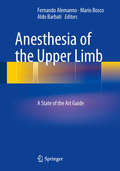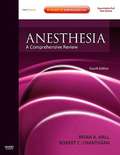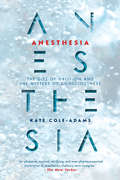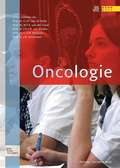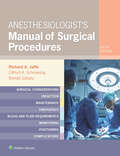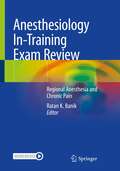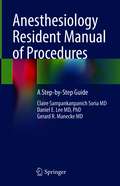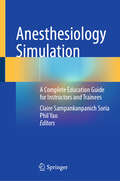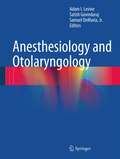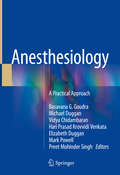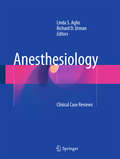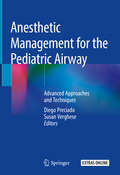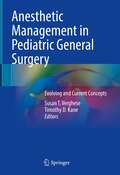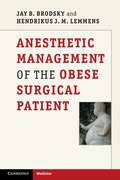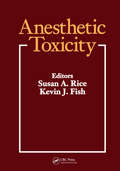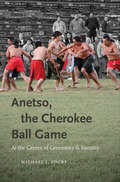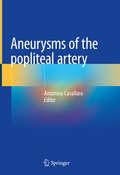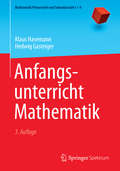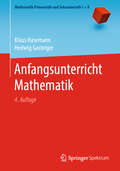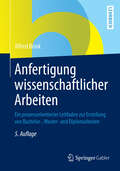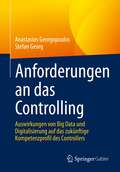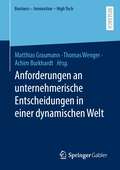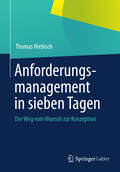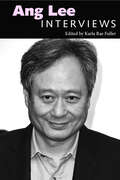- Table View
- List View
Anesthesia of the Upper Limb: A State of the Art Guide
by Fernando Alemanno Mario Bosco Aldo BarbatiLoco-regional anesthesia offers evident advantages in almost all branches of surgery since it couples perfect anesthesia with prolonged postoperative analgesia. Furthermore, new drugs and techniques are ensuring constant progress, and in the past decade the advent of ultrasound-guided regional anesthesia has played a key role by allowing direct visualization of all anatomic structures involved in regional blocks. In conjunction with electrostimulation, it has significantly increased the success rate of loco-regional anesthesia. This book, comprising 16 chapters and more than 140 color illustrations, provides detailed coverage of the techniques currently employed in upper limb anesthesia. It opens by reviewing the anatomy of the brachial plexus and the topographic anatomy as it is of the utmost importance for anesthesiologists to have a deep knowledge of anatomy despite the assistance offered by new tools. Subsequently the various techniques, including supraclavicular, infraclavicular, and axillary brachial plexus blocks, peripheral blocks, and intravenous regional anesthesia, are discussed in depth, with due attention to potential complications. Up-to-date information is also provided on the role of ultrasound, and an entire chapter is devoted to ultrasound-guided interscalene and supraclavicular blocks. The book will be an invaluable learning tool for students and an excellent aid in daily clinical practice for anesthesiologists.
Anesthesia: A Comprehensive Review (Fourth Edition)
by Brian A. Hall Robert C. ChantigianAnesthesia: A Comprehensive Review is an invaluable study tool for certification and recertification as well as a superb way to ensure mastery of all the key knowledge in anesthesiology. Brian A. Hall and Robert C. Chantigian present nearly 1000 completely updated review questions-vetted by Mayo residents-that cover the latest discoveries and techniques in physics, biochemistry, and anesthesia equipment; the newest drugs and drug categories; and the most recent information on all anesthesia subspecialties. They cover everything from the basic sciences to general anesthesia and subspecialty considerations, with an emphasis on the most important and clinically relevant principles. Access discussions of each question as well as page references to major anesthesia texts. With online access to the text at expertconsult. com, you'll have the ultimate review guide for the ABA written exam. Tests your knowledge of anesthesia through the most comprehensive coverage of basic science and clinical practice for an effective review. Features questions vetted by Mayo residents to ensure a consistent level of difficulty from trustworthy sources. Features the full text online at expertconsult. com for convenient reference. Presents 997 thoroughly revised questions for the most current and comprehensive review of board material, covering the latest discoveries and techniques in physics, biochemistry, and anesthesia equipment; the newest drugs and drug categories; and the most recent information on all anesthesia subspecialties. Complies with the new ABA format so you have an accurate representation of the new question style and can prepare effectively. Includes discussions after each question, along with references to major anesthesia texts so it's easy to find more information on any subject.
Anesthesia: The Gift of Oblivion and the Mystery of Consciousness
by Kate Cole-Adams"An obsessive, mystical, terrifying, and even phantasmagorical exploration of anesthesia’s shadowy terra incognita." —The New YorkerAnesthetize: to render insensibleFirst there’s the injection, then the countdown—and next thing you know, you’re awake. Anesthesia: The Gift of Oblivion and the Mystery of Consciousness is the story of the time in between, an exploration of that most crucial and baffling gift of modern medicine: the disappearing act that enables us to undergo procedures that would otherwise be impossibly, often fatally, painful. In the past 150 years, anesthesia has made surgical intervention routine, from open–heart surgery to the facelift. But how much do anesthesiologists really know about what happens when their patients go under? Can we hear and retain what’s going on? Is pain still pain if we don’t remember it? How does the unconscious mind deal with the body’s experience of being sliced open and ransacked—and how can we help ourselves through it all?Kate Cole–Adams weaves her own personal experiences with surgery and its aftermath with the explorations and personal accounts of others, doctors and patients alike—accounts of people who wake under the knife, who experience traumatic reactions, dreams, hallucinations, and submerged memories—accounts that evoke and illuminate the provisional nature of the self.Haunting, lyrical, sometimes shattering, Cole–Adams leavens science with personal experience, and brings an intensely human curiosity to the unknowable realm beyond consciousness.
Anesthesiologie (Quintessens)
by P. J. Hennis J. A. LeusinkAnesthesiologen hebben een breed takenpakket, zich uitstrekkend van het zelf uitvoeren van algehele en regionale anesthesie op behandel- en operatiekamers tot de coördinatie van behandeling en logistiek op de afdelingen spoedeisende hulp en intensive care. Nu eens zetten zij hun vakkennis in voor een pasgeborene van een halve kilogram, dan weer voor een hoogbejaarde patiënt met een marginale hartfunctie. De anesthesiologie heeft raakvlakken met zowel de beschouwende als de snijdende disciplines en vervult daardoor een spilfunctie in het ziekenhuis. Leerboek anesthesiologie biedt een gedegen basis voor dit veelzijdige vak. Deze herziene en geactualiseerde druk bestaat uit zes delen: het operatiekamercomplex, monitoring en apparatuur; farmaca; basisprincipes van anesthesie en intraoperatieve problematiek, preoperatieve screening; speciële anesthesie; postoperatieve zorg, pijnbestrijding en reanimatie. Elk hoofdstuk begint met een korte inleiding, bevat een discussie over een controversieel onderwerp in de anesthesiologie en eindigt met een samenvatting in kernpunten. In de operatiekamer is het contact met de patiënt vaak van korte duur, terwijl de anesthesioloog op de intensive care en bij de chronische pijnbestrijding een langduriger contact met de patiënt heeft. Veel anesthesiologen hebben zich gespecialiseerd in de intensivecaregeneeskunde, in bestrijding van chronische pijn of in de palliatieve zorg. De anesthesioloog speelt ook een beslissende rol in reanimatiesituaties. Ook op deze onderwerpen wordt ingegaan. Leerboek anesthesiologie is bestemd voor studenten geneeskunde, anesthesieverpleegkundigen en -technici en assistenten anesthesiologie en chirurgie. Het boek is geschreven door anesthesiologen die werkzaam zijn in opleidingscentra voor anesthesiologie en perifere ziekenhuizen in Nederland.
Anesthesiologist's Manual of Surgical Procedures
by Richard A. Jaffe Clifford Schmiesing Brenda GolianuCovering both surgical and anesthetic considerations, Anesthesiologist’s Manual of Surgical Procedures, Sixth Edition, is an essential resource for formulation of an anesthetic plan and perioperative management of patients. All chapters are written by both surgeons and anesthesiologists, giving you a detailed, real-world perspective on the many variables that accompany today’s surgical procedures.
Anesthesiology In-Training Exam Review: Regional Anesthesia and Chronic Pain
by Ratan K. BanikFocused on rotations in regional anesthesia and chronic pain, this book provides a structured review of the concepts covered in the American Board of Anesthesiology in-training exam. The first section of the book covers regional anesthesia with dedicated chapters on basic science, acute postoperative pain, and nerve blocks for neuraxial, lower and upper extremity blocks, and head and neck. The second section on chronic pain includes chapters on basic science and common pain conditions - including craniofacial pain, CRPS, neuropathic pain, and cancer pain. This section closes on multimodal analgesia and other treatment approaches. Each chapter presents a common clinical topic and is organized by indications, preparation, technique, complication, prevention, clinical pearls, and related ABA key points. Highlights must-know information in bold throughout the text. Concise, practical, and easy-to-read, this book will aid anesthesiology residents, certified nurse anesthetists, and medical students in their study regarding patient care practices on regional anesthesia and chronic pain. The book will also be useful to residents going into regional anesthesia and pain medicine subspecialties during the year of their anesthesiology training.
Anesthesiology Resident Manual of Procedures: A Step-by-Step Guide
by Claire Sampankanpanich Soria MD Daniel E. Lee MD, PhD Gerard R. Manecke MDThis book describes in concise yet detailed step-by-step instructions on how to perform common procedures, including complex airway management, vascular access, neuraxial blocks, and nuanced anesthetic techniques; it not only covers this breadth of procedures, but presents them in an accessible manner. Chapters follow the format of the indications for a particular procedure, a list of equipment required, step-by-step instructions for performing the procedure, common complications, and troubleshooting techniques. The book is designed intentionally for the busy physician to be able to easily read the essential information, including lists of equipment necessary, numbered steps to perform the procedure, tables of common errors and methods to troubleshoot, indications and contraindications for procedures, detailed photos of equipment setup, and handmade diagrams and images. Anesthesiology Resident Manual of Procedures is comprehensive and written with the physician-in-training in mind, as well as those who are completing their residency or fellowship in the fields of anesthesiology, critical care medicine, and emergency medicine.
Anesthesiology Simulation: A Complete Education Guide for Instructors and Trainees
by Claire Sampankanpanich Soria Phil YaoThis book is a curriculum that is essentially an easy-to-follow educational instruction manual. It is a ready-made simulation program that any instructor, whether they are a physician in training or in practice, can read and execute. It is designed so that an instructor can select a topic, open that chapter, and with appropriate simulation equipment and staff, run an entire simulation scenario from start to finish. Each chapter is a unique medical case that concludes with an associated scoring rubric for learners. It sets clear expectations for clinical knowledge as well as leadership and communication skills. Students can also use the scoring rubrics as self-evaluations to identify areas for improvement. Anesthesiology Simulation presents classic index cases that every anesthesiologist, general surgeon, and obstetrician/gynecologist should know how to handle. These are simulation cases that were written to be done together, with surgeons or obstetricians collaborating with anesthesiologists.
Anesthesiology and Otolaryngology
by Adam I. Levine Samuel Demaria Jr. Satish GovindarajTo an unusual degree, the shared "working space" of otolaryngologists and anesthesiologists means that issues important to one are important to the other. Anesthesiology and Otolaryngology is the first book to address the closely overlapping information needs of both groups of specialists. It is collaboratively written and edited by anesthesiologists and otolaryngologists, and the chapters are carefully designed to insure maximal relevance to members of both specialties. The heart of the book consists of chapters on managing patients during the full range of otolaryngologic procedures. These chapters are structured chronologically, and otolaryngologic and anesthesiologic perspectives are systematically presented for each operative stage. Foundational topics such as gross and radiographic anatomy, physiology, and pharmacology are covered. The book includes a unique chapter on oxygen delivery systems that serves as a comprehensive review for anesthesiologists and an overview for the otolaryngologist. Special topics addressed include acute and chronic pain management, and the logistics of managing an office-based surgical practice. · "All-in-one" reference for otolaryngologists and otolaryngologic anesthesiologists · Surgical and anesthesiologic perspectives marshaled for pre-operative, intraoperative, and postoperative periods · Pearls and Insights at end of chapters · Organized by surgical region · Special challenges of difficult airway and of pediatric otolaryngologic procedures addressed
Anesthesiology: A Practical Approach
by Mark Powell Basavana G. Goudra Preet Mohinder Singh Michael Duggan Vidya Chidambaran Hari Prasad Venkata Elizabeth DugganThis book provides a practical approach to the anesthetic management of surgical and nonsurgical procedures across the spectrum of anesthesia sub-specialties. This book will assist the practitioner to plan their anesthetic from preoperative evaluation phase to complete recovery or transfer to another special care area. The emphasis is on both the planned technique and more importantly the logic or reasoning behind the suggested technique.This book addresses all important procedures in anesthesiology, including preoperative evaluation, airway management, and fluid administration. Every chapter discusses a specific surgery or procedure. Some topics of special interest are also included.Anesthesiology: A Practical Approach is aimed at anesthesia residents, anesthesia nurse practitioners, and experienced anesthesiologists called upon to work in any area or anesthetizing location.
Anesthesiology: Clinical Case Reviews
by Richard D. Urman Linda S. AglioDivided into twelve sections that cover the entirety of anesthetic practice, this is a case-based, comprehensive review of anesthesiology that covers the basics of anesthetic management and reflects all new guidelines and recently developed standards of care. Each chapter of Anesthesiology: Clinical Case Reviews begins with a specific clinical problem or a clinical case scenario, followed by concise discussions of preoperative assessment, intraoperative management, and postoperative pain management. In addition to residents and fellows, this book is written for practicing anesthesiologists, student nurse anesthetists, and certified registered nurse anesthetists (CRNAs).
Anesthetic Management for the Pediatric Airway: Advanced Approaches And Techniques
by Diego Preciado Susan VergheseThe advancement of tactics used in managing pediatric airway disorders can be attributed to an overall growth of collective knowledge among medical health professionals. This book is designed to sustain that growth of knowledge, with 18 chapters of insight and information by distinguished medical experts in both pediatric anesthesia and pediatric otolaryngology. It concisely and thoroughly covers topics such as subglottic stenosis, pharyngeal airway obstruction, laryngeal airway obstruction, obesity and sleep apnea and thoracic airway obstruction, among others. Chapters include scenarios where the skills and expertise of both anesthesiologists and otolaryngologists are being continually tested; the use of newer drugs and repurposing of older drugs; the combination of smaller amounts of different types of sedatives while avoiding intra-op narcotics and maintaining spontaneous ventilation are described in detail; Finally, a comprehensive review of new research emerging about ultra-rapid narcotics metabolizers among patients, making them more susceptible to medications, such as codeine, along with the latest information on the purported potential neurodevelopmental toxicity of some anesthetic agents are also included. Working as both an educational tool and a practical resource, medical practitioners, students and educators will find this text to be a valuable tool for the safely managing the pediatric patient undergoing anesthesia for difficult airway scenarios.
Anesthetic Management in Pediatric General Surgery: Evolving and Current Concepts
by Susan T. Verghese Timothy D. KaneThis book highlights remarkable new endoscopic, laparoscopic, and thoracoscopic approaches to the removal of surgical lesions for different pathologic conditions under general endotracheal anesthesia in infants and children. It details how newer techniques in airway management, monitoring, regional nerve blocks for these innovative minimally invasive approaches have resulted in a decrease in intraoperative and postoperative morbidity and early recovery process after pediatric anesthesia. This unique book contains features that provide the audience with several clinical scenarios where exceptional surgical outcomes are achieved with optimum pre-op preparation via collaborative team efforts. To date there is no other textbook emphasizing the anesthetic and surgical management during the most innovative advances in endoscopic surgery in children. Per oral endoscopic myotomy (POEM) for the definitive treatment of achalasia in children is probably the most advanced endoscopic surgery done successfully in children. POEM is the best example of endoscopic surgery performed via natural orifices known as the Natural orifice transluminal endoscopic surgery (NOTES). Another new laparoscopic surgical intervention -Median Arcuate Ligament surgical release for Median Arcuate Ligament Syndrome (MALS) for patients with Postural Orthostatic Tachycardia Syndrome (POTS) is described with established perioperative protocols emphasizing the need for early admission, intravenous hydration, and premedication. Novel approaches in the anesthetic management in children with short bowel syndrome for bowel lengthening techniques like the serial transverse enteroplasty (STEP) and in teenagers for laparoscopic bariatric surgery with adjustable gastric banding (AGB) and vertical sleeve gastrectomy (VSG) for morbid obesity are new areas that would enlighten the readers. Anesthetic Management in Pediatric General Surgery is an invaluable resource for pediatric anesthesiologists, surgeons, and their trainees specializing in the care of pediatric patients.
Anesthetic Management of the Obese Surgical Patient
by Jay B. Brodsky Hendrikus J. LemmensThe global obesity epidemic is growing in severity, affecting people of every age and costing healthcare providers millions of dollars every year. Every day, anesthesiologists are presented with obese and morbidly obese patients undergoing every type of surgical procedure; the management of these patients differs significantly from that of normal weight patients undergoing the same procedure. Anesthetic Management of the Obese Surgical Patient discusses these specific management issues within each surgical specialty area. Initial chapters describe pre-operative assessment and pharmacology; these are followed by detailed chapters on the anesthetic management of a wide variety of surgical procedures, from joint replacement to open heart surgery. Essential reading for anesthesiologists and nurse anesthetists worldwide, Anesthetic Management of the Obese Surgical Patient and its companion work by the same authors, Morbid Obesity: Peri-operative Management, enable both trainees and practised professionals to manage this complex patient group effectively.
Anesthetic Toxicity
by Kevin J. Fish Susan A. RiceThis text is a source of information on the toxicity of anaesthetic agents. The editors define toxicity in a broad sense to mean an adverse effect, whether that effect is the result of pharmacological, toxicological, physiological, or other mechanisms. They bring together reviews by experts in the disciplines concerned - including biochemistry, gen
Anetso, the Cherokee Ball Game At the Center of Ceremony and Identity
by Michael J. ZogryAnetso, a centuries-old Cherokee ball game still played today, is a vigorous, sometimes violent activity that rewards speed, strength, and agility. At the same time, it is the focus of several linked ritual activities. Is it a sport? Is it a religious ritual? Could it possibly be both? Why has it lasted so long, surviving through centuries of upheaval and change? Based on his work in the field and in the archives, Michael J. Zogry argues that members of the Eastern Band of Cherokee Nation continue to perform selected aspects of their cultural identity by engaging in anetso, itself the hub of an extended ceremonial complex, or cycle. A precursor to lacrosse, anetso appears in all manner of Cherokee cultural narratives and has figured prominently in the written accounts of non-Cherokee observers for almost three hundred years. The anetso ceremonial complex incorporates a variety of activities which, taken together, complicate standard scholarly distinctions such as game versus ritual, public display versus private performance, and tradition versus innovation. Zogry's examination provides a striking opportunity for rethinking the understanding of ritual and performance as well as their relationship to cultural identity. It also offers a sharp reappraisal of scholarly discourse on the Cherokee religious system, with particular focus on the Eastern Band of Cherokee Nation. Anetso, a centuries-old Cherokee ball game still played today, is a vigorous, sometimes violent activity that rewards speed, strength, and agility. At the same time, it is the focus of several linked ritual activities. Is it a sport? Is it a religious ritual? Could it possibly be both? Why has it lasted so long, surviving through centuries of upheaval and change?
Aneurysms of the Popliteal Artery
by Antonino CavallaroPopliteal aneurysms are still controversial in terms of their pathogenesis, and challenging in terms of their treatment. This book offers a detailed overview of the latest advances in our understanding of the disease, and highlights the latest theories. Divided into eght sections, it focuses on: the historical background, embryology and anatomy of the popliteal artery, clinical presentation and diagnosis, pros and cons of traditional surgical techniques, pros and cons of advanced endovascuar techniques. The last section focuses on non-atherosclerotic popliteal aneurysme, i.e. on diseases in which popliteal aneurysms may specifically appear, rendering more challenging the diagnosis and the treatment As stressed in the foreword by the Chief Editor of the Journal of Vascuar Surgery, this book, given its scope, offers a valuable guide for all health professionals - experts and in training -.involved in vascular pathology and surgery.
Anfangsunterricht Mathematik (Mathematik Primarstufe und Sekundarstufe I + II)
by Klaus Hasemann Hedwig GasteigerEs gibt zahlreiche wissenschaftliche Studien, die zeigen, wie wichtig frühe mathematische Kenntnisse für den späteren Lernerfolg sind. Der mathematische Anfangsunterricht hat deshalb für die Lernentwicklung der Kinder richtungweisende Bedeutung, wobei die individuellen Kenntnisse und Fähigkeiten der Kinder berücksichtigt werden müssen. Dieses Buch widmet sich deshalb zunächst der Entwicklung des mathematischen Verständnisses von den ersten Lebensjahren bis zum Schuleintritt und geht auf Möglichkeiten mathematischer Förderung im Kindergarten ein. Auf lerntheoretischer Basis werden die Inhalte des Anfangsunterrichts in der Schule - Zahlbegriffserwerb, elementares Rechnen, geometrische Fragestellungen sowie Größen und Sachrechnen - ausführlich beschrieben und in praktischen Beispielen konkretisiert. Auch spezielle Zielgruppen, wie Kinder mit Schwierigkeiten beim Mathematiklernen oder mit besonderen Begabungen werden dabei berücksichtigt. Die 3. Auflage wurde neu strukturiert. Ein besonderer Fokus der Neubearbeitung lag auf dem Mathematiklernen im Übergang vom Kindergarten zur Grundschule. Zudem wurden zahlreiche neue Erkenntnisse aus dem Bereich der Vorkenntnisuntersuchungen, der Arbeit mit lernschwachen Kindern und zum Mathematiklernen allgemein eingearbeitet.
Anfangsunterricht Mathematik (Mathematik Primarstufe und Sekundarstufe I + II)
by Klaus Hasemann Hedwig GasteigerEs gibt zahlreiche wissenschaftliche Studien, die zeigen, wie wichtig frühe mathematische Kenntnisse für den späteren Lernerfolg sind. Der mathematische Anfangsunterricht hat deshalb richtungweisende Bedeutung. Für eine gelingende mathematische Lernentwicklung der Kinder ist es wichtig, die individuellen Kenntnisse und Fähigkeiten der Kinder zu kennen, um daran anknüpfen zu können. Dieses Buch widmet sich deshalb zunächst der Entwicklung des mathematischen Verständnisses in den ersten Lebensjahren bis zum Schuleintritt und geht auf Möglichkeiten mathematischer Förderung in Kindertagesstätten ein. Auf fachdidaktischer und lerntheoretischer Basis werden die Inhalte des Anfangsunterrichts in der Schule – Zahlbegriffserwerb, elementares Rechnen, geometrische Fragestellungen sowie Größen und Sachrechnen – ausführlich beschrieben und in praktischen Beispielen konkretisiert. Schwerpunkte sind dabei die Arbeit mit geeigneten Arbeitsmitteln und mit digitalen Medien. Im Fokus der unterrichtlichen Arbeit stehen Kinder mit verschiedenen Voraussetzungen und Fähigkeiten. Deshalb werden auch spezielle Zielgruppen wie Kinder mit Schwierigkeiten beim Mathematiklernen oder mit besonderen Begabungen berücksichtigt. In dieser 4. Auflage sind neben etlichen Farbabbildungen und kleineren inhaltlichen Änderungen auch Abschnitte zu elektronischen Arbeitsmitteln hinzugekommen. Hier liegt der Fokus auf Potenzial und Einsatzmöglichkeiten von Tablets und interaktiven Whiteboards, wobei auch erste Erfahrungen bei ihrem Einsatz im mathematischen Anfangsunterricht diskutiert werden.
Anfertigung wissenschaftlicher Arbeiten: Ein prozessorientierter Leitfaden zur Erstellung von Bachelor-, Master- und Diplomarbeiten
by Alfred BrinkDieses Buch ist aus Intensivseminaren zum Anfertigen von Abschlussarbeiten entstanden, die der Autor seit fast zwei Jahrzehnten in jedem Semester an der Westfälischen Wilhelms-Universität Münster hält. Der praktische Leitfaden ist Lehrbuch und Nachschlagewerk zugleich. Der Aufbau entspricht den Arbeitsphasen einer wissenschaftlichen Arbeit und ist damit der ideale Begleiter für alle, die an einer Arbeit schreiben oder sich darauf vorbereiten. Die vorliegende fünfte Auflage wurde grundlegend überarbeitet und aktualisiert. Speziell für Abschlussarbeiten in englischer Sprache, die an deutschen Hochschulen immer häufiger verlangt werden, bietet der Autor im Online-Service zum Lehrbuch unter "Zusätzliche Information" ein ergänzendes E-Booklet zum Download auf www. springer-gabler. de an.
Anforderungen an das Controlling: Auswirkungen von Big Data und Digitalisierung auf das zukünftige Kompetenzprofil des Controllers
by Stefan Georg Anastasios GeorgopoulosDie Chancen, die Big Data und Digitalisierung bieten, bringen für Unternehmen und ihre Funktionsbereiche weitreichende Änderungen mit sich - so auch für das Controlling. Die Autoren analysieren die aufgabenbezogenen Trends im Controllingumfeld und leiten die Anforderungen ab, die sich daraus für das Kompetenzprofil des Controllers ergeben. Ausgewählte Angebote zur Weiterbildung und Kompetenzerweiterung als klassisches Weiterbildungsangebot oder als Studiengang runden die Analyse ab.
Anforderungen an unternehmerische Entscheidungen in einer dynamischen Welt (Business - Innovation - High Tech)
by Matthias Graumann Achim Burkhardt Thomas WengerUnternehmerische Entscheidungen profitieren vom Rückgriff auf wissenschaftliches Wissen. Es leitet nicht nur das methodische Vorgehen beim Treffen von Entscheidungen an, sondern stellt auch konkrete Ursache-Wirkungs-Beziehungen zur Verfügung. Auf diese Weise unterstützt die Wissenschaft die Beantwortung praktischer Fragen, was die Autoren dieses Sammelbandes anhand zahlreicher Beispiele aus Organisation, Führung und Marketing illustrieren.
Anforderungsmanagement in sieben Tagen: Der Weg vom Wunsch zur Konzeption
by Thomas NiebischObwohl professionelles Anforderungsmanagement als unbestrittene Notwendigkeit für den Erfolg von IT-Projekten gilt, werden die dafür erforderlichen Kenntnisse oft nur einzelnen Spezialisten zugeschrieben. Das Ergebnis der IT-Projekte könnte deutlich positiver ausfallen, wenn maßgebliche Projektbeteiligte wie Projektmanager, Entscheidungsträger oder Fachspezialisten ebenfalls mit den wesentlichen Aspekten des Anforderungsmanagements vertraut wären. Diesem Gedanken folgend ist es an der Zeit, das Anforderungsmanagement für Jedermann verständlich vorzustellen. Dieses Buch beschreibt anhand einer konkreten Aufgabenstellung alles Wissenswerte rund um das Anforderungsmanagement für diejenigen, die mit IT-Anforderungen konfrontiert werden, ohne selbst Anforderungsmanager zu sein. Didaktisch ist der zu vermittelnde Inhalt auf sieben Tage verteilt, an denen die Vorgehensschritte durch zwei handelnde Protagonisten diskutiert werden.
Ang Lee: Interviews (Conversations with Filmmakers Series)
by Karla Rae FullerTaiwanese born, Ang Lee (b. 1954) has produced diverse films in his award-winning body of work. Sometimes working in the West, sometimes in the East, he creates films that defy easy categorization and continue to amaze audiences worldwide. Lee has won an Academy Award two times for Best Director--the first Asian to win--for films as different as a small drama about gay cowboys in Brokeback Mountain (2005), and the 3D technical wizardry in Life of Pi (2012). He has garnered numerous accolades and awards worldwide.Lee has made a broad range of movies, including his so-called "Father Knows Best" trilogy made up of his first three films: Pushing Hands (1992), The Wedding Banquet (1993), and Eat Drink Man Woman (1994), as well as 1970s period drama The Ice Storm (1997), martial arts film Crouching Tiger, Hidden Dragon (2000), superhero blockbuster Hulk (2003), and hippie retro trip Taking Woodstock (2009).Thoughtful and passionate, Lee humbly reveals here a personal journey that brought him from Taiwan to his chosen home in the United States as he struggled and ultimately triumphed in his quest to become a superb filmmaker. Ang Lee: Interviews collects the best interviews of this reticent yet bold figure.
Angaliyat Semester 4 - Kutch University Guidebook: આંગળિયાત સેમિસ્ટર 4 - કચ્છ યુનિવર્સિટી ગાઈડબુક
by Kutch Universityઆ પુસ્તક ક્રાંતિગુરુ શ્યામજી કૃષ્ણવર્મા કચ્છ યુનિવર્સિટીના જૂન: 2016 - 17 થી અમલમાં આવેલા નવા અભ્યાસક્રમ (CBCS) અનુસાર પ્રથમ વર્ષ બી.એ. ગુજરાતી વિષયના વિદ્યાર્થીઓ માટે ઉપયોગી છે.
